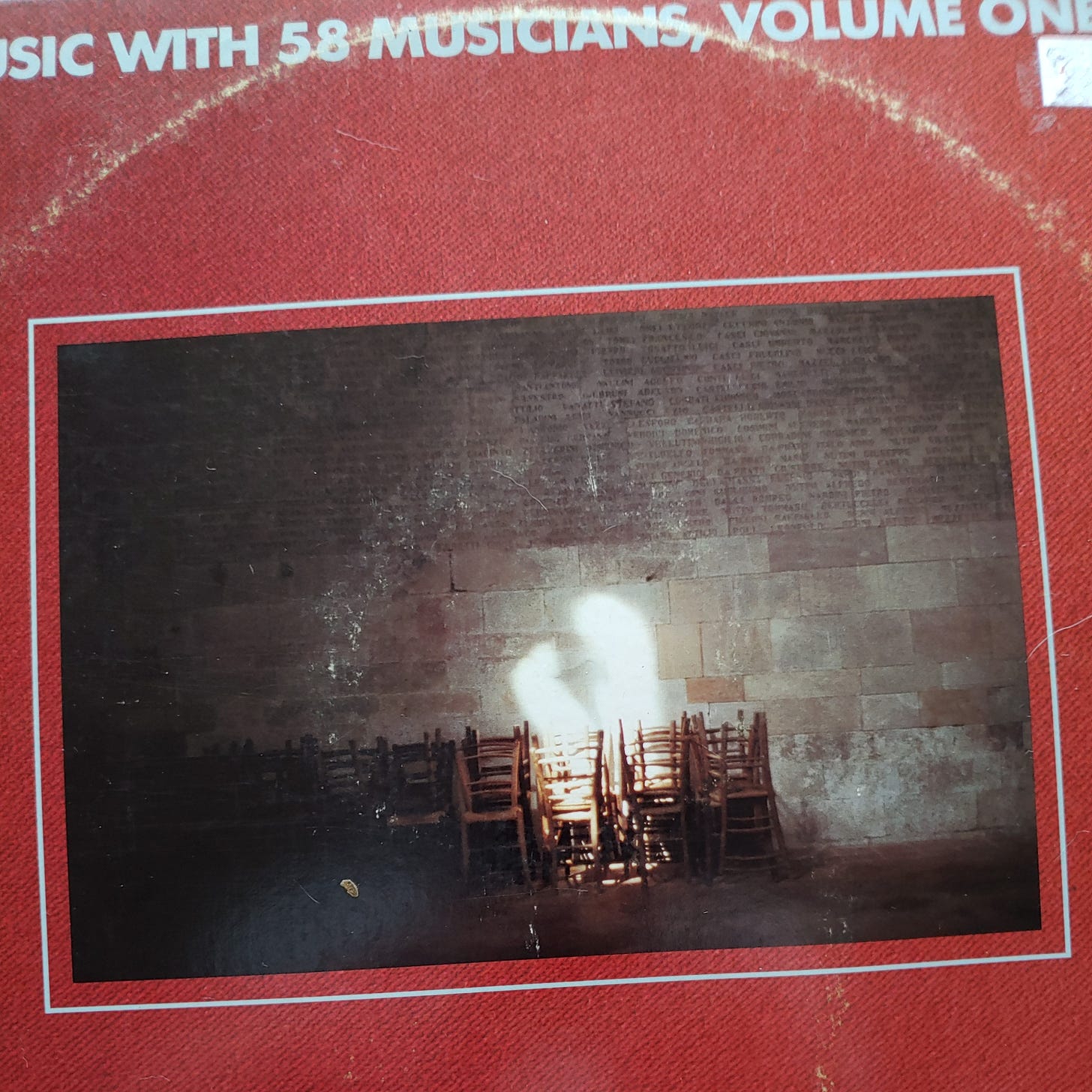This week's NDIM has a couple of familiar angles to regular readers: ECM Records and Compilations. To be specific, the ECM compilation Music With 58 Musicians, Volume One, released in 1980. At the time ECM's U.S. manufacturing and distribution deal were with Warner Brothers--a change from its original arrangement with Polydor. Original Polydor pressings of classic ECM records (for example, Crystal Silence by Chick Corea & Gary Burton) did not sound good, with recordings often marred by clicks and pops from surface imperfections--a problem for a label whose motto was 'The Most Beautiful Sound Next to Silence.'
I'm not certain to what extent Warner had any influence over ECM's marketing at the time (probably none), but the idea of creating a double LP sampler of the variety of music on the label is right out of the Warner Loss Leaders playbook. Warner released its last Loss Leader, Troublemakers, in 1980 as well. The CD era was at hand, and it may have helped kill off the series, but in the meantime, Warner pressed and distributed this compilation for ECM.
The 1980s were definitely a new period in the life of the label, and it met the decade with a sense of brash enthusiasm and bold new energy tempered by a melodic sweetness that bordered on--dare I say it? Folk music. Folklore. What folk? Everyday people folk. I mean, in looking over the length and breadth of this collection, there are healthy doses of Black American gospel mixed with an open heartland feeling and rhythm that seems to derive inspiration from Copeland and Ives. There are European folk-like sounds, Nordic and otherwise, that also filter through. There are cross-cultural projects like Cordona and Magico and there are the groups that create their own mythology, like Jack DeJohnette's Special Edition or Art Ensemble of Chicago, heard here doing free jazz meets reggae on "Ja."
One thing that makes Music with 58 Musicians a treat and a departure from most ECM releases is that it includes liner notes, written by producer and writer Steve Lake. Lake has some words for those who would try to assign microgenres to ECM records or who seek to find the core elements that make something an ECM record: you are wasting your time.
"Who knows, maybe such an album might also help reconcile the partisan fan of, say, the Pat Metheny group to the music of the Art Ensemble of Chicago. And vice versa. Because, in a way, the differences in the surface structure of the pieces here--which critics delight in cataloging in terms of "style" (jazz, rock, jazz-rock, fusion, classical, neo-classical), "School" (the ECM school, the New Cool and other idiocies), "colour" (black, white, etc.) or geography (American, European)-- are much less important than the strength that sustains all of them and which might be translated as spirit, integrity, seriousness of intent and so forth. These are the qualities we're looking to find at ECM and categories are what we are trying to transcend."
The collection opens with the Keith Jarrett track "Country" from the My Song album that featured the group that came to be known as Jarrett's 'European' quartet--Jan Garbarek, Palle Danielsson, and John Christensen. Lake reminds us that Garbarek's 1970 album Afric Pepperbird helped draw Jarrett into the ECM circle in the first place, pulled by the spirit and integrity of the label's sound and by Garbarek's playing as well, and so the formation of this group seems somewhat destined--Lake refers to the group as Belonging, using the name of the group's first recording together. The group was the outlet for Jarrett's brighter, more melodic music, and Lake suggests that the term 'jazz' is wholly insufficient to cover the depth of the well Jarrett is mining, suggesting it is more akin to folk music. "Joni Mitchell could sing this one," he writes, referring to "Country," "returning the compliment perhaps for Keith's arrangement of "All I Want?" That's a reference to the version of Mitchell's song Jarrett recorded on Mourning of a Star, his 1971 Atlantic album on which he also plays flute and soprano sax.
Garbarek is also present on the culture-spanning Magico recording with Charlie Haden and Egberto Gismonti, and listening to the final tracks on this compilation, "Magico" and the Pat Metheny Group's fusion band as rock stars approach to "(Cross the) Heartland" from American Garage, one is struck by the way the two groups use different means to push the same energy. Charlie Haden is well known and his playing has always conveyed the feeling of folk music with a distinctly American feel, and Gismonti is equally well known for integrating his guitar voice into new infusions of Brazilian music and sounds that have no geographic point of origin. The energy they spin is magical, as their name implies, and it dovetails perfectly with the gorgeous introduction Lyle Mays sprinkles onto the Metheny group's "Heartland." You really can't overestimate Mays' influence on the sound of this band, and he and Metheny were involved in projects outside of the Group, such as touring with Joni Mitchell (there she is again!). Mays' solo ECM recordings are different than his work with the Metheny Group, but they are excellent in their own right.
Codona is a deliberate attempt to mix cultural elements in pursuit of a 'Universal world folklore," in the words of Don Cherry. Both Cherry and Colin Wolcott have made such universal folklore the focus of much of their work. It was hearing work like this title track featuring Cherry on flute and Wolcott on hammered dulcimer that really opened up my ears to not only music that we in the West like to think of as 'avant-garde,' but also to music from other cultures, and I was much more open to music performed by artists outside the mainstream.
The spirit of Ornette Coleman looms large over Music With 58 Musicians, both in terms of his compositions and his influence over musicians heard on these various ECM projects. The group Old and New Dreams was the first avant-garde supergroup, made up of musicians who had played and recorded with Coleman in various groups: Cherry, Dewey Redman (who went on to play with Keith Jarrett's 'American' Quartet), Charlie Haden (see Magico, Jarrett) and Ed Blackwell, who has recorded extensively with Coleman as well as with Cherry. The idea of the band wasn't to recreate their previous performances of Coleman's work but to play the pieces according to their firsthand experience with Coleman's harmolodic conception. And they succeeded.
Two drummers who were a large part of the ECM firmament were Jack DeJohnette and Paul Motian. Both were incredible drummers who rejected the role of timekeeper early on in their careers. Both could easily play inside or outside, though both examples here are 'outside' projects--The Paul Motian Trio's La Voyage and JaceJohnette's first Special Edition record. DeJohnette's track, "Journey to the Twin Planet" bristles with energy and an Afrofuturistic vibe while Motian's brings a prayerful melodic statement straight into an extended drum solo that holds the listener's interest throughout.
One recording that looms large over the compilation, extending even to the homage contained in its title, is the Steve Reich Ensemble performance of "Music For 18 Musicians." Lake laments the fact that the vinyl could only contain 6:44 of the piece, an issue that is corrected by our playlist, which includes the nearly-hour-long piece in its entirety. Reich, whose music is generally categorized as 'minimalist' or 'avant-garde' says that he simply calls what he does 'music.' Listening to this seminal piece, you hear its influence on EDM, on soundtracks, on hip hop, on rock music, Radiohead, and on so much other music that ECM later recorded. It's especially wonderful that ECM captured its performance by the Steve Reich Ensemble. Like the music of Philip Glass, Sun Ra, or Duke Ellington, Reich's music demanded precision and it demanded performers who were specifically trained in the finer points of the composer's work.
There's more here, of course--Terje Rypdal, Gary Burton & Chick Corea, Ralph Towner & John Abercrombie, Steve Kahn with Sheila Jordan-- and all of it provides its own unique view of the ECM sound, which, it turns out, is somehow about being part of a community that is both where you are physically and where your mind and spirit dwell. I deeply recommend a vinyl copy of this record to anyone who is fascinated by music from everywhere and nowhere at once and I have included the Spotify playlist near the beginning of the article for your enjoyment.
Bonus Tracks
Lou Ottens, the man who invented and designed the cassette tape, has died at the age of 94. Ottens wanted music to be portable and accessible to people, and he encouraged Philips, the technology company for whom he worked, to license the cassette's design for other companies to use for free, helping to make the cassette a standard worldwide. Cassette tapes have been largely replaced for music listeners by the advent of CDs and streaming, but they survive with a certain group of musicians and listeners because of their ease of use, low cost, and easy replication. You don't have to look far to find musicians and companies using cassettes to release new music on Bandcamp. A little over a year ago, I wrote about the history of cassettes and about mixtapes, an idea that grew out of the availability of the cassette and influenced the recording of mix CDs and playlists in the digital age.
Sally Grossman, who was Albert Grossman's wife, has died at the age of 81. Albert managed Bob Dylan and also The Band in the sixties, and Sally posed with Dylan on the iconic cover of Bringing it All Back Home. After her husband died of a heart attack on a transatlantic flight in 1986, Sally took over the running of the legendary Bearsville studio in Woodstock, NY, and the Bearsville record label. Photographer Daniel Kramer took the soft-focus shot used on the record's cover as well as several other shots at the home of the Grossman's early in 1965. The chaise that Sally reclines on in the photo was a wedding gift to the Grossmans from Mary Travers of Peter, Paul & Mary.
The 2021 Grammy Award telecast was predictably less than interesting, with huge label-promoted acts winning the top awards as usual. But on the non-televised award front, there were some great musicians and records being nominated and, in some cases, winning awards. Chick Corea received posthumous awards for his Trilogy 2 album with Brian Blade and Christian McBride and for his solo on "All Blues." Other musicians nominated in the category included Christian Scott Atunde Adjuah, Regina Carter, Joshua Redman, and Terry Lynn Carrington. Chicago singer Kurt Elling won for Best Jazz Vocal Album for Secrets are the Best Stories featuring Danilo Perez. The Maria Schneider Orchestra took home Best Large Jazz Ensemble Album for her big band record Data Lords. John Prine, who died of COVID-19 complications last April, received awards for his album I Remember Everything and its title track song. Bobby Rush won Best Traditional Blues Album for Rawer Than Raw. You can review a complete list of nominees and winners here.
Leaving you this week with Bunny Wailer, who passed away this week as well. Bunny was the last surviving original member of the Wailers trio which included Bob Marley, and Peter Tosh. You can read his BBC obituary here. This track, "Cool Runnings" comes from Wailer's 1981 album Rock 'n' Groove.
I want to thank everyone who reads NDIM on a regular basis as well as those who have signed up for a free subscription or who have already supported us with a paid subscription. I'll be posting some things for paid subscribers in March and am grateful to readers for supporting the newsletter and blog and helping to grow this venture into its next exciting phase.
Have a terrific week, and I look forward to our next meeting.




